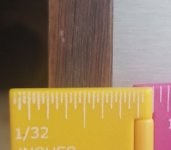I notice there are a lot of Horizons where the cover didn't survive at all or is in deplorable condition.
I've got at least a couple that need covers. If someone could provide some pictures and dimensions, I could investigate making a couple.
If there were interest, I could make some more while I was at it.
So, drawings, dimensions, and pictures would help me out.
thanks,
I've got at least a couple that need covers. If someone could provide some pictures and dimensions, I could investigate making a couple.
If there were interest, I could make some more while I was at it.
So, drawings, dimensions, and pictures would help me out.
thanks,


